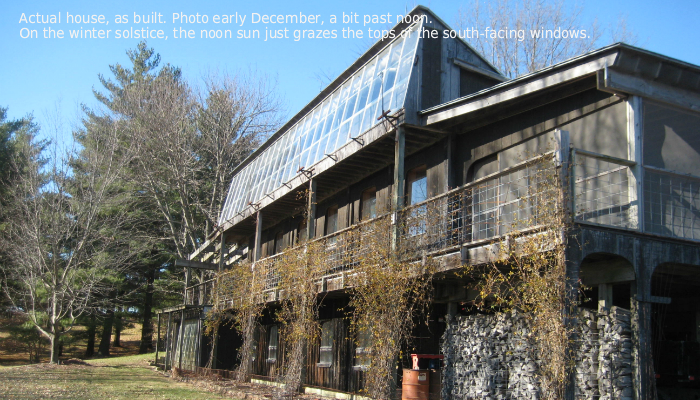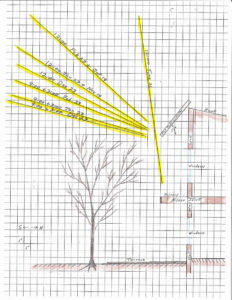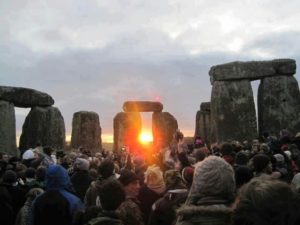The Winter Solstice and Nature’s Cycles

Back in 1973, when designing our house, I needed to know seasonal sun angles in order to optimize winter heat gain and summer shade, avoid tree shadows on the solar collector, and know how deeply the sun would go into rooms in the winter.

Different sun angles on select dates and times, including winter and summer solstice.
Determining the cardinal directions to align the house was done on a clear night by putting two tall stakes in the ground so I could aim across their tops to the polar star. The sun angles were then found by setting out a four-foot-tall rod in the yard and measuring its shadow at different times of different days and graphing up a family of curves. These distances could then be transferred directly to a graph paper cross-section without even using trigonometry (see illustration).
The actual construction was informed by this graphic and is quite similar to the concept.
Our ancestors all had uses for some sort of calendar. The hunter-gatherers needed to know when to travel to intercept the caribou herd or the shad coming up the river. For agriculturalists, the timing of the rainy season or the first frost was important. For seafarers, the cycles of the trade winds and doldrums ruled their lives. And the winter solstice and summer solstice were markers on the annual calendar which were 100% reliable and easily measured. Your observatory only needed to be a vertical stick and some pegs in the ground to mark certain shadows.
More permanent observatories were built of stone, with windows or slots where a ray of sunshine would illuminate a spot on a wall or stela; Stonehenge is still celebrated today.
In many older cultures, the winter solstice sunrise is a substantial event and people go out in the dark, sometimes in processions, to some prominence to greet the dawn of the new solar year. Cemeteries were sometimes placed on hilltops and worshipers could greet the dawn with their ancestors, and acknowledge that they too are part of the great cycle of life.
Unfortunately, our modern world is losing contact with the cycles of the natural world. Neither my university calendar nor my home planning calendar even mention the winter solstice. Increasingly, modern people spend their days sitting before a screen, living in a world that is information-rich and experience-poor. And for every topic, there are people on somebody’s payroll to spin “information” so the profits continue, and information addicts just wind up in gridlock. Taking action usually requires experience. You can read gigabytes about the trashing of our rivers, but it is all sorta abstract until you canoe up to a rotting cow carcass caught in barbed wire stretched across the stream.
And so too many people remain distanced from the earth’s cycles and think that it is all too complicated to take action. For example, the carbon cycle, which has sustained us for millennia, becomes more unbalanced every year. The consequences are greater extremes in weather patterns, more often. Just since August, there has been hurricane Harvey in Texas, dumping so much rain that the Weather Bureau had to create new map categories. And then the Santa Rosa wine country fire in October, one of the larger ones on record. And now the chain of fires, Santa Barbara – Ventura – Los Angeles – San Diego, still mostly out of control as I write this on December 12th, with at least 200,000 people evacuated. The modeling increasingly says more drought for California, because the rains will shift north to coastal Canada and Alaska, where they already get a lot and don’t need the floods. It is no longer a question of how precise a particular climate model might be, it is already happening, we are already living it in real time, not some predicted or imagined future. Don’t just sit there – do something!!



